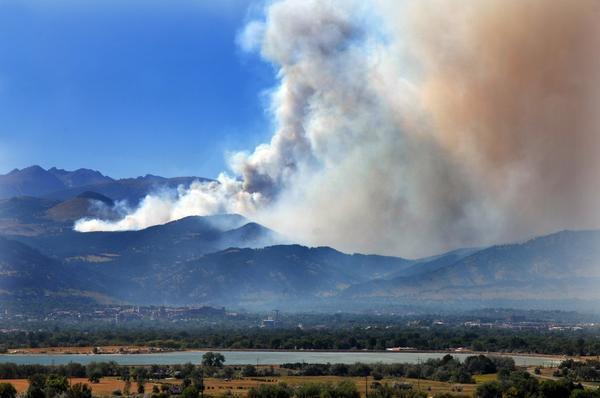In our hyperactive media climate, where every incident is proof or not proof of something, it has become common to see claims that wildfires have become worse due to global warming even as American CO2 emissions have dropped.
Scientists have put a fire retardant on claims that Colorado's Front Range wildfires are becoming increasingly severe.
The study authors looked at 1.3 million acres of ponderosa pine and mixed conifer forest from Teller County west of Colorado Springs through Larimer County west and north of Fort Collins, reconstructed the timing and severity of past fires using fire-scarred trees and tree-ring data going back to the 1600s. Only 16 percent of the study area showed a shift from historically low-severity fires to severe, potential crown fires that can jump from treetop to treetop.

A new study indicates present-day forest fires on Colorado's Front Range are not significantly more intense than historical fires. Credit: Glenn Asakawa, University of Colorado
The idea that modern fires are larger and more severe as a result of fire suppression that allowed forest fuels to build up in the past century is still prevalent among some, said co-author University of Colorado Boulder geography Professor Thomas Veblen. "The key point here is that modern fires in these Front Range forests are not radically different from the fire severity of the region prior to any effects of fire suppression."
"The common assumption is that fires are now more severe and are killing higher percentages of trees," said Rosemary Sherriff, who completed her doctorate at CU-Boulder under Veblen in 2004. "Our results show that this is not the case on the Front Range except for the lowest elevation forests and woodlands."
One important new finding comes from a comparison of nine large fires that have occurred on the Front Range since 2000 -- including the 2002 Hayman Fire southwest of Denver, the 2010 Fourmile Canyon Fire west of Boulder and the 2012 High Park Fire west of Fort Collins -- with historic fire effects in the region.
"It's true that the Colorado Front Range has experienced a number of large fires recently," said Schoennagel. "While more area has burned recently compared to prior decades – with more homes coming into the line of fire – the severity of recent fires is not unprecedented when we look at fire records going back before the 1900s."
In addition, tree-ring evidence from the new study shows there were several years on the Front Range since the 1650s when there were very large, severe fires. The authors looked at more than 1,200 fire-scarred tree samples and nearly 8,000 samples of tree ages at 232 forest sample sites from Teller County to Larimer County.
The study is one of the largest of its kind ever undertaken in the western United States. The team was especially interested in fire records before about 1920, when effective fire suppression in the West began in earnest.
"In relatively dry ponderosa pine forests of the West, a common assumption is that fires were relatively frequent and of low severity, and not lethal to most large trees, prior to fuel build-up in the 20th century," said Veblen. "But our study results showed that about 70 percent of the forest study area experienced a combination of moderate and high-severity fires in which large percentages of the mature trees were killed."
Along the Front Range, especially at higher elevations, homeowners and fire managers should expect a number of high-severity fires unrelated to any kind of fire suppression and fuel build-up, said Schoennagel. "This matters because high-severity fires are dangerous to people, kill more trees and are trickier and more expensive to suppress."
"Severe fires are not new to most forests in this region," said Sherriff. "What is new is the expanded wildland-urban interface hazard to people and property and the high cost of suppressing fires for society."
In addition, a warming Colorado climate -- 2 degrees Fahrenheit since 1977 -- has become a wild card regarding future Front Range fires, according to the team. While fires are dependent on ignition sources and can be dramatically influenced by high winds, the team expects to see a substantial increase in Front Range fire activity in the low and mid-elevations in the coming years as temperatures continue to warm, a result of rising greenhouses gases in Earth's atmosphere.




Comments